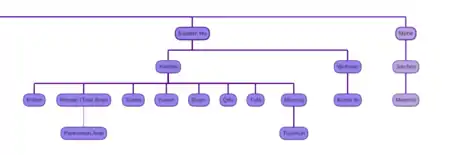Mohe people
The Mohe, Malgal, or Mogher, or Mojie,[1] were historical groups of people that once occupied parts of Southeastern Siberia in what's now Northeast Asia during late antiquity. The two most well known Mohe groups were known as the Heishui Mohe, located along the Amur River, and the Sumo Mohe, named after the Songhua River.[2] They have been traditionally defined by their eastwards proximity to Goguryeo as well as the approximate use of what would have been Proto-Tungusic languages. The Heishui Mohe are commonly thought as being direct ancestors to the 12th century Jurchens.
| Mohe people | |||||||||||||
|---|---|---|---|---|---|---|---|---|---|---|---|---|---|
| Chinese name | |||||||||||||
| Chinese | 靺鞨 or 靺羯 | ||||||||||||
| |||||||||||||
| Korean name | |||||||||||||
| Hangul | 말갈 | ||||||||||||
| Hanja | 靺鞨 | ||||||||||||
| |||||||||||||
| History of Manchuria |
|---|
 |
The Mohe constituted a major part of the population in the kingdom of Balhae in northeast Asia, which lasted from the late 7th century to early 10th century. After the fall of Balhae, few historical traces of the Mohe can be found, though they are considered to be the primary ethnic group from whom the Jurchen people descended. The Heishui Mohe in particular are considered to be the direct ancestors of the Jurchens, from whom the 17th century Manchu people and Qing dynasty founders originated.[3] The Mohe practiced a sedentary agrarian lifestyle and were predominantly farmers who grew soybean, wheat, millet, and rice, supplemented by pig raising and hunting for meat.[4][5] The Mohe were also known to have worn pig and dog skin coats.[6]
Name
The Chinese exonym Mohe (靺鞨) is a graphic pejorative written with mo 靺 "socks; stockings" and he 鞨 "shoes". Mo (靺) (Middle Chinese: /muɑt̚/) is an adjective, a customary expression meaning "barbarian" or Xiongnu. Before the Five dynasties period, it was recorded as "靺羯", such as on the Honglujing Stele.
He 鞨 is gal (Middle Chinese gat or /ɦɑt̚/), meaning "stone" by Mohe/Malgal, Jie/Gal language. The Jie ruler Shi Le (石勒) takes the surname shi (石 "stone") from gal. According to the History of Jin (Jin Shi), Shi Tumen (石土門) is the prince of the Jurchen people, whose surname shi hints to a connection with the Mohe and Jie.
The ethnonym of the Mohe bears a notable resemblance to that of the later historically attested *Motgit in Middle Chinese (Chinese: 勿吉; pinyin: mò jí; Jyutping: mat6 gat1; Korean: 물길 [Mulgil]; Japanese: もつきつ [Motsukitsu]).
The name of the Mohe also appears as "Maka" in "Shin-Maka" (Japanese 新靺鞨, しんまか) or "New Mohe," which is the name of a dance and the musical piece that accompanies it; the dance and song were introduced to the Japanese court during the Nara period or around the beginning of the Heian period from the Balhae kingdom. In modern Japanese historical texts, the name of the Mohe is annotated with the "kana" reading Makkatsu (まっかつ), which is probably a transliteration based on the standard Sino-Japanese readings of the Chinese characters used to transcribe the ethnonym of the Mohe.
Tribes

According to some records, there were seven/eight Mohe tribes :
| Moji/Merjie/Wuji/Matgat (勿吉) | Mohe/Mogher/Malgal/Muthot (靺鞨) | Modern location | Settlements |
|---|---|---|---|
| Sumo tribe 粟末部 (Sùmò Bù) 속말부 (Songmalbu) |
Sumo tribe 粟末部 (Sùmò Bù) 속말부 (Songmalbu) |
near Songhua River | |
| Baishan tribe 白山部 (Báishān Bù) 백산부 (Baeksanbu) |
Baishan tribe 白山部 (Báishān Bù) 백산부 (Baeksanbu) |
near Paektu Mountain | |
| Yulou tribe 虞婁 (Yúlóu) 우루 (Uru) |
Yulou tribe 虞婁 (Yúlóu) 우루 (Uru) |
on the Suifun River Basin | |
| Boduo tribe 伯咄部 (Bóduō Bù) 백돌부 (Baekdolbu) |
Boduo tribe 伯咄部 (Bóduō Bù) 백돌부 (Baekdolbu) |
near the Lalin River | |
| Funie tribe 拂涅部 (Fúniè Bù) 불열 (Buryeol) |
Funie tribe 拂涅部 (Fúniè Bù) 불열 (Buryeol) |
near the Mudan River on the Khanka Basin | dwelled in Jixi and Mudanjiang |
| Anchegu tribe 安車骨部/安车骨部 (Ānchēgǔ Bù) 안차골부 (Anchagolbu) |
Tieli tribe 鐵利 (Tiělì) 철리 (Cheolli) |
near the Songhwa River | dwelled in Harbin |
| Haoshi tribe 號室部/号室部 (Hàoshì Bù) 호실부 (Hosilbu) |
Yuexi tribe 越喜 (Yuèxǐ) 월희 (Wolhui) |
dwelled in Dalnerechensk | |
| Heishui tribe 黑水部 (Hēishuǐ Bù) 흑수부 (Heuksubu) |
Heishui tribe 黑水部 (Hēishuǐ Bù) 흑수부 (Heuksubu) |
low banks of Amur River | dwelled in Hegang, Jiamusi, Shuangyashan, Khavarovsk, Birobidzhan, Yichun |
Notable personalities
Prefecture Mohe chieftains
- Sumo Mohe
- Baishan Mohe
- Geolsa Biu (乞四比羽 pinyin: Qǐsì Bǐyǔ, Hangul: 걸사비우)
- Heisui Mohe
- A Tou (阿頭 pinyin: Ā Tóu, Manchu: Uju (head, chief), Hangul:아두)
- Tou Fu (陁弗 pinyin: Toú fú, Hangul: 타불)
- Su Wugai (蘇勿蓋 pinyin: Sū Wùgài, Manchu: Sotki (crusian), Hangul: 소홀개)
- Gao Zhimen (高之門 pinyin: Gāo Zīemén, Manchu: Hocihon mangga (handsome and strong), Hangul: 고지문)
- Wusukemeng (烏素可蒙 pinyin: Wū sù kě méng, Manchu: Osohon mangga (small but strong), Hangul: 오소고몽)
- Nisuliji (倪屬利稽 pinyin:Ní shǔ lì jī, Manchu: Nisurigi (finger ring for archery), Hangul: 아속리계)
- Funie Mohe
- Yuexi Mohe
See also
- Balhae
- Jie people (Gal people)
- Shi Le
- Guanqiu Jian
References
Citations
- "唐与渤海、靺羯关系史上的两次出使".
- Crossley 1997, p. 18.
- Huang, P.: "New Light on the origins of the Manchu," Harvard Journal of Asiatic Studies, vol. 50, no.1 (1990): 239-82. Retrieved from JSTOR database July 18, 2006.
- Gorelova 2002, p. 14.
- Aisin Gioro & Jin, p. 18.
- Gorelova 2002, pp. 13-4.
Bibliography
- Aisin Gioro, Ulhicun; Jin, Shi. "Manchuria from the Fall of the Yuan to the rise of the Manchu State (1368-1636)" (PDF). Retrieved 10 March 2014.
- Crossley, Pamela Kyle (1997), The Manchus, Blackwell Publishing
- Gorelova, Liliya M., ed. (2002). Handbook of Oriental Studies. Section 8 Uralic & Central Asian Studies, Manchu Grammar. Vol. Seven Manchu Grammar. Brill Academic Pub. ISBN 9004123075. Retrieved 6 May 2014.
